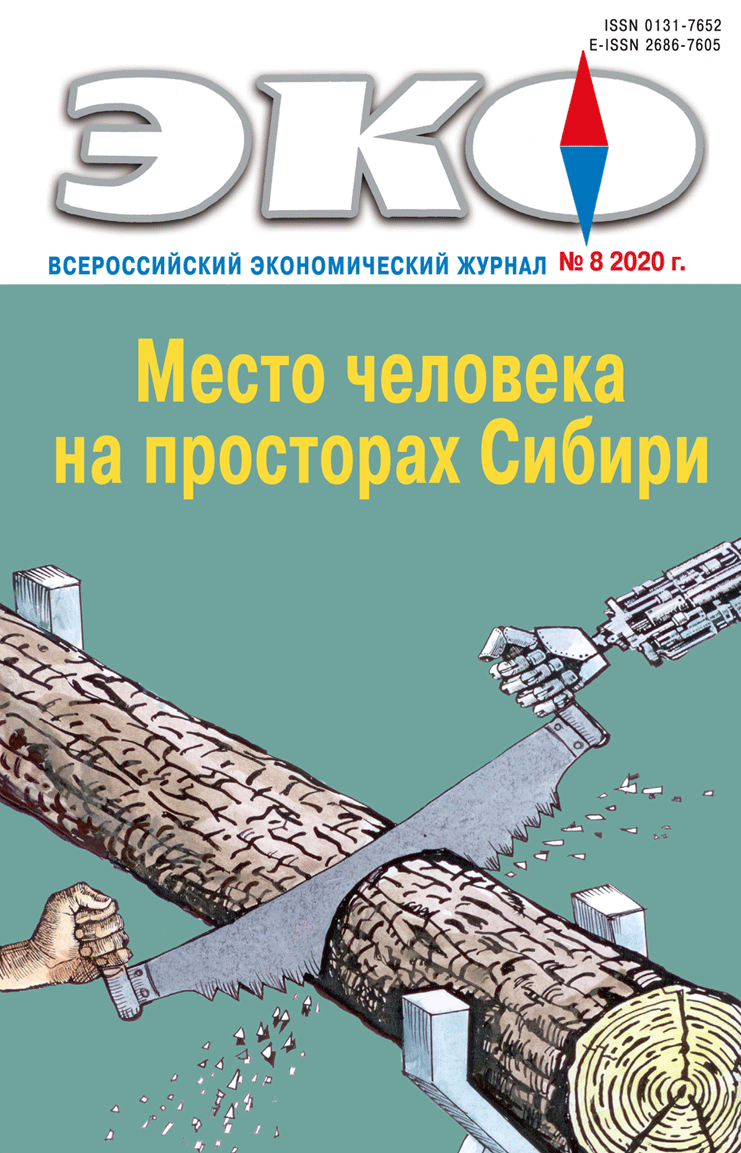Тема номера: Место человека на просторах Сибири
Published 2020-08-08
Keywords
- population,
- spatial structure of production,
- growth rate,
- climate,
- transport
- income distribution,
- correction ...More
How to Cite
1.
Ershov Ю, Tarasova О. Asian Russia – Main Contradictions of Current Development. ECO [Internet]. 2020 Aug. 8 [cited 2026 Jan. 11];50(8):8-30. Available from: https://ecotrends.ru/index.php/eco/article/view/4087
Abstract
The paper explains why Siberia and the Far East, which are many times superior to the European part of the country in terms of territory and availability of natural resources, since the beginning of market reforms, have changed their development trend to a slower one (relative to the Russia’s average). This trend has led to a drop in the share of the macro-region in the total GRP, population and employment in the economy. The main reasons for such changes in the spatial structure of the economy, which are directly opposite to those that took place in the Soviet period, are shown. These factors do not include climate differences or transportation distances – these factors have existed in the past. The first reason for the trend change is a long and deep economic crisis, which caused a sharp reduction in investment and new construction, which previously provided the accelerated growth of Asian Russia’s economy. The second is a change in the distribution of income from economic activities between direct producers and other participants in this activity. It is noted that the main consequence of these changes is concentration of income in the capital region, and that the European “periphery” has suffered even more than Asian Russia.References
- Аганбегян А. Г., Ибрагимова З. М. Сибирь на рубеже веков. М.: Советская Россия, 1984. 252 с.
- Аганбегян А. Г., Ибрагимова З. М. Сибирь не понаслышке. М.: Молодая гвардия, 1981. 252 с.
- Данилов-Данильян В. Книжка Паршева – бальзам для патриотов самого разного толка, но с содержательной точки зрения – чушь. Интервью от 19.02.2002. URL: http: //www.r-reforms.ru/indexpub190.htm (дата обращения: 15.03.2020).
- Ершов Ю. С. Межрегиональная дифференциация, регионы-доноры и регионы-реципиенты: многообразие оценок и выводов // Регион: экономика и социология. 2019. № 1. С. 3–22.
- Ершов Ю. С. Особенности национальной экономики, или почему Россия не стала Америкой. И не будет, если… // ЭКО. 2016а. № 2. С. 69–92.
- Ершов Ю. С. Особенности национальной экономики, или почему Россия не стала Америкой. И не будет, если… (окончание) // ЭКО. 2016b. № 3. С. 6–29.
- Мельникова Л. В. А была ли дискуссия? // ЭКО. 2005. № 12. С. 67–85. Мельникова Л. В. Освоение Сибири: ревнивый взгляд из-за рубежа // ЭКО. 2004. № 6. С. 99–119.
- Орешкин Д. Климат и А. П. Паршев как жертвы аборта. URL: https://web.archive.org/web/20190503143411/http://www.libros.am/book/read/id/156580/slug/klimat-i-a-p-parshev-kak-zhertvy-aborta (дата обращения: 15.03.2020).
- Орлов Б. П. Сибирь сегодня: проблемы и решения. М.: Мысль, 1974. 208 с.
- Очерки экономики Сибири / ИЭОПП СО АН СССР. Новосибирск: Наука, Сиб. отд-е, 1980. 352 с.
- Паршев А. П. Почему Россия не Америка. М.: Крымский мост-9Д, 2001. 411 с.
- Сибирь в едином народнохозяйственном комплексе / Отв. ред. М. К. Бандман, В. А. Калмык, Б. П. Орлов, З. Р. Цимдина; ИЭОПП СО АН СССР. Новосибирск: Наука. Сиб. отд-е, 1980. 336 с.
- Сибирь в первом десятилетии XXI века / Отв. ред. В. В. Кулешов. Новосибирск, Изд-во ИЭОПП СО РАН, 2008. 788 с.
- Сибирь на пороге нового тысячелетия / Отв. ред. В. В. Кулешов, ИЭОПП СО РАН, Новосибирск, 1999. 296 с.
- Современная роль экономики Сибири в народнохозяйственном комплексе России / Под ред. В. В. Кулешова. ИЭОПП СО РАН, Новосибирск, 2014. 326 с.
- Ханин Г. И. Почему Россия не Америка. Размышления над книгой. URL: http: //www.ieie.nsc.ru/eco/arhiv/ReadStatiy/03_01/Hanin.htm
- Akhtamov E., Bezrukov L., Bragin V., Brukhanova E., Danilova V., Efimov A., Efimov V., Ershov Y., Gergilev D., Kolomyts L., Kozyr V., Krukov V., Lapteva A., Makarov I., Malov V., Sarchenko V., Shishatsky N., Tarasova O., Voronov Yu. Siberia and the Far East in XXI Century: Problems and Perspectives of Development: Scientific Report: Translated from Russian / ed. by V. Efimov; Siberian Federal University, Strategic Research Fund “Siberian Club”. Krasnoyarsk: SibFU, 2017. 182 p.
- Hill F., Gaddy C. The Siberian Curse: How Communist Planners Left Russia Out in the Cold. Brookings Institution Press, 2003. 240 p.
- Landes D. The Wealth and Poverty of Nations: Why Some are so Rich and Some so Poor. N.Y.: Norton, 1998. XXII, 650 p.
- Yershov Yu. S. Features of Regional Economic Development in Russia in 1999–2013. DOI: 10.1134/S2079970516040079 // Regional Research of Russia. 2016. Vol. 6, Is. 4. P. 281–291.

